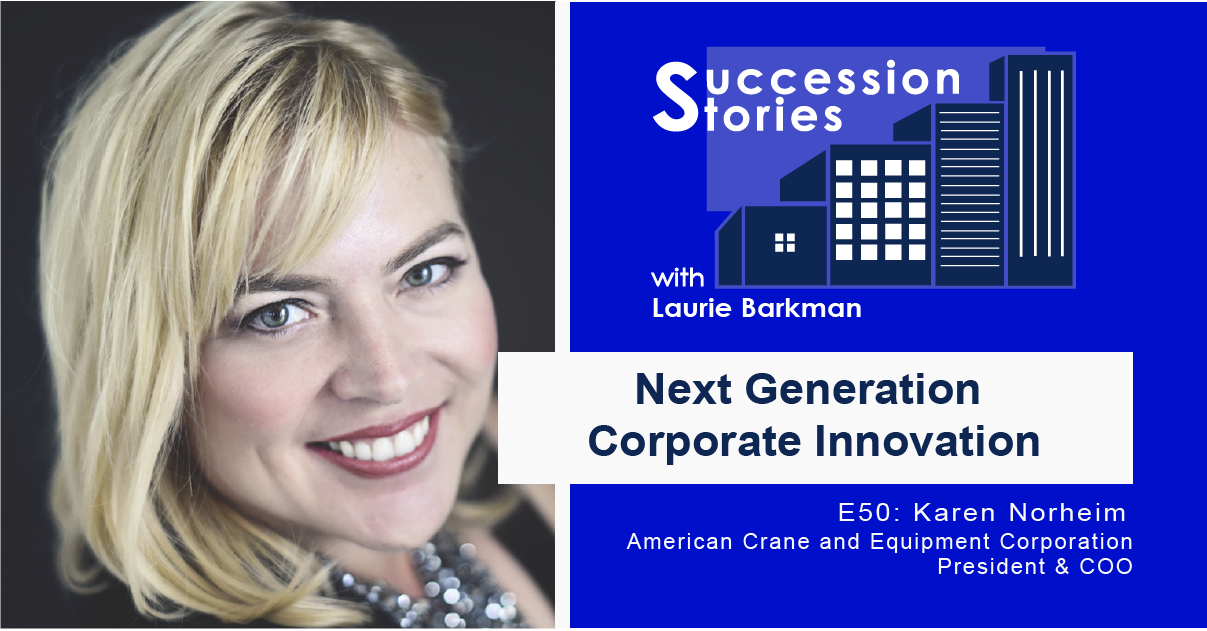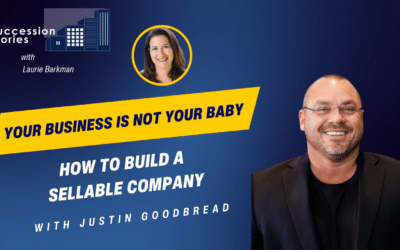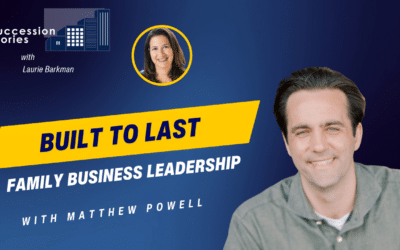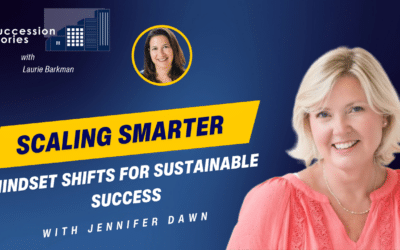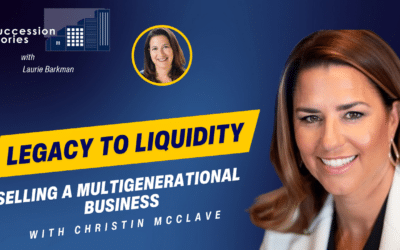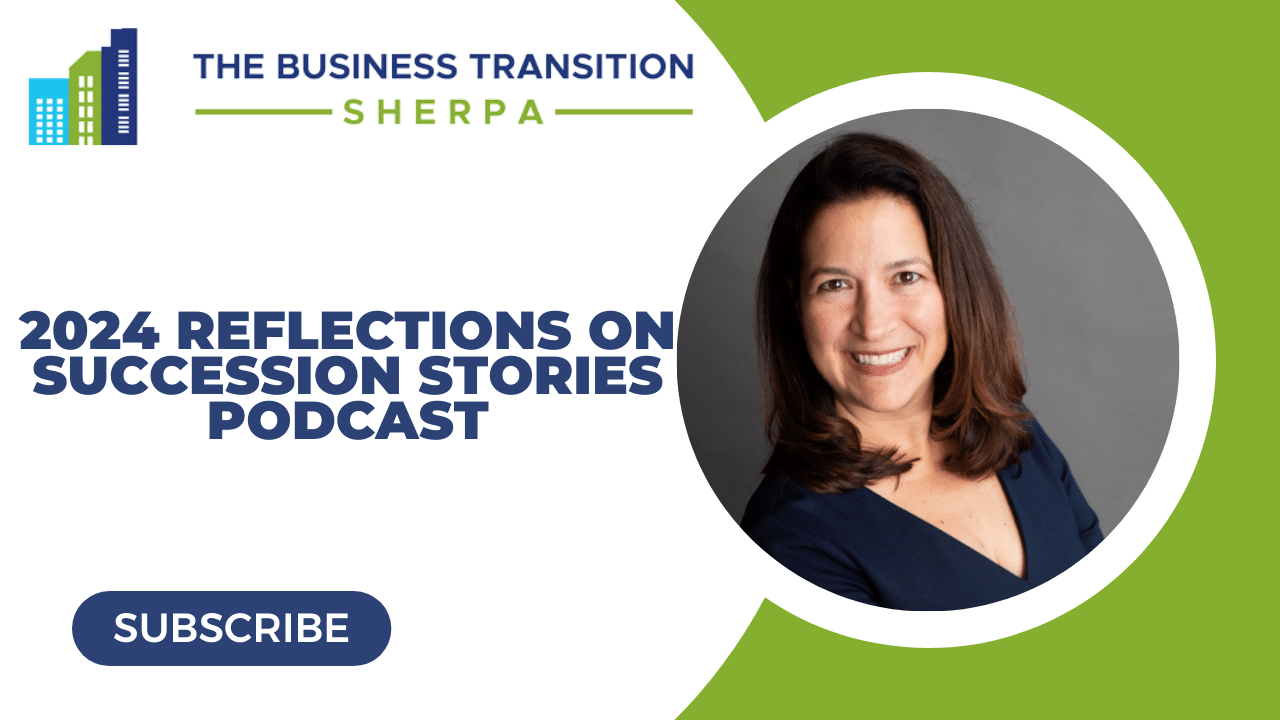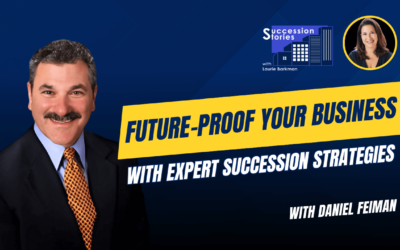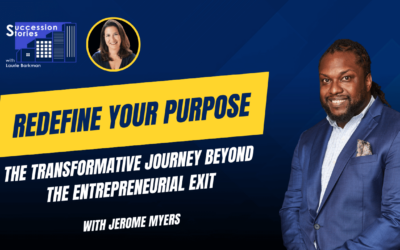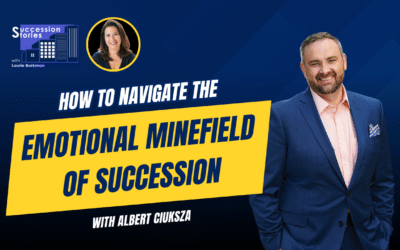Karen Norheim is the President of American Crane and Equipment Corp, a specialized manufacturing company, founded by her father. Karen shared her story as the next generation and how she’s taking the company to the next level. In early 2020, the company launched an Innovation Lab and has started to implement digital transformation technologies like IoT and virtual reality. One of Karen’s favorite sayings is to “Be comfortable being uncomfortable,” which has helped her find her way in challenging times. Listen in as Laurie Barkman talks with Karen about the importance of embracing disruptive change not only because of the pandemic, but as a way to invest in your future.
Listen in to learn more about:
- Driving transformation by embracing and learning from disruption and change
- Aligning your sense of self, your beliefs and your profession
- Enhancing communication, collaboration, and productivity in today’s new normal
- Integrating digital transformation into business process
Show Links:
Karen Norheim on LinkedIn
https://www.linkedin.com/in/karennorheim
Youtopian
Transcript:
Laurie Barkman:
Karen Norheim, good morning. How are you?
Karen Norheim:
I am great. How about yourself?
Laurie Barkman:
I’m great. It’s snowing, so if anyone’s listening to this at some point in the future, we are getting dumped on and it’s a beautiful day. I am really glad that you’re here with me on Succession Stories, not only because you’re second generation, but you’re a fantastic leader of a really interesting company called American Crane. I’m looking forward to learning about you, the company and also what you’re doing with digital innovation and transformation. I want to share with the listeners first how we got connected, because I think it’s an important part of the story here, which is, we got connected by Lisa Griegel, who works at Thomas, and the CEO of Thomas, Tony Uphoff, who’s a friend of yours, and you were on his podcast probably a while ago now. He was the very first guest of my show and the theme of that interview when I talked with Tony was about corporate innovation in a mature company. So here we are full circle, and that’s a core part of what we’re going to talk about today, so welcome.
Karen Norheim:
Well, thanks so much for having me and I have to say I listened to Tony’s podcast with you. It was wonderful. He is such a great insight for business leaders, so I really enjoyed it and I’m excited to be here today with you.
Laurie Barkman:
Great, why don’t we start by you telling us about the company? What does American Crane do?
Karen Norheim:
American Crane is a leading manufacturer of overhead cranes and hoists as well as other material handling equipment. We’re really passionate about delighting our customers. What’s really cool about our equipment is, it’s really a tool, a very large tool that you can use in your manufacturing facility or utilities, nuclear power plants; there’s a lot of our equipment in energy, and what’s really interesting is there are so many different applications. Not only do we build complex, amazing equipment, but we also serve a wide variety of customers and it makes it really exciting.
Laurie Barkman:
Who are some of your customers that we might be familiar with?
Karen Norheim:
We have done work with Boeing. Our equipment is actually used in their Dreamliner facility in South Carolina. We’ve also done work for NASA so our cranes have been used to lift spacecraft, which is really exciting. We’re currently working with them on their Orion project so really, I’m a big space — I don’t know, I love it. It’s so much fun, so I’m kind of a space geek. It’s really exciting and inspiring to be able to work with them, and then other big utilities such as Exelon and Dominion. We do a lot of work in the nuclear energy space and also other general manufacturing as well.
Laurie Barkman:
That’s really cool. These are highly specialized cranes, these are not the kind of crane you’re gonna go see on a construction site. These are permanent, and very large installations, so that’s pretty cool. How old is the company?
Karen Norheim:
We will be turning 50 next year so we are 49 this May. It’s very, very exciting.
Laurie Barkman:
And the company was founded by your father, is that right?
Karen Norheim:
Yeah. One of the major milestones of my life was coming to work for my dad. At the time, I did not think manufacturing was all that cool. What were these things called cranes and hoists? It turned out to be one of the best decisions of my life. It has been over 18 years since I came to American Crane and I’ve really found my passion for manufacturing. I’ve fallen in love with our products and our amazing people so it’s really been a wonderful place to have landed.
Laurie Barkman:
Very cool. Let’s talk a little bit about that. What’s your background? You didn’t start out thinking, “Hey, I’m going to go work in manufacturing for my dad.” You studied what in college?
Karen Norheim:
I was a business major. I had an international business and marketing degree and so I was working in several different industries. Actually, the last industry before American Crane was the ski industry. I worked for Stratton Mountain in their marketing and communications department and my father recruited me to come and work for him. I really was reluctant at the time. My background really is in marketing and then after coming and working for him, I ended up getting the IT department as part of my function so I was in charge of marketing and IT when I came there. While I’m a tech junkie and I love technology, and I’ve always been very savvy with computers, it wasn’t my background so I went back to grad school again, for a Master’s of Information Science and an MBA, all from Penn State. We’re from Pennsylvania, so we are Penn State and love Penn State.
Laurie Barkman:
Which part of Pennsylvania are you in?
Karen Norheim:
We’re located in Douglasville, which is about 45 minutes northwest of Philadelphia, so we’re on the eastern side of the state.
Laurie Barkman:
Gotcha. What was that conversation like between you and your dad? Did he call you out of the blue and say, “Hey, Karen, I want you to work with me. Come join the company,”?
Karen Norheim:
I think he’d been planning this for a little while and he knew that I was kind of at a turning point where I was considering what my next move was. He just kind of swooped in and he said, “I’d like you to come and work for me and see if this is something you want to do.” I’ve had a lot of amazing things in my life that have been because of my father. He’s an immigrant from Norway. He came to the US when he was in his 20s and he really took American Crane from a struggling enterprise into a thriving business. So I was intrigued and decided that it was something that I needed to go and do. I didn’t negotiate for more money of course, way back when, and then I came to give it a shot. I said, “Dad, if I don’t like this, I’m gonna move on.” But it turned out, it’s amazing. It’s really cool to be able to take things from a piece of paper and turn them into physical existence. I have so much appreciation, I’m very proud of all our people, and the type of engineering that we do, and the type of products that we get to build. It’s very exciting and it’s very rewarding. Really an incredible place to be. We have about 170 employees just to give you kind of a scale of the size.
Laurie Barkman:
Karen, when your dad approached you about joining the company, was he clear about his intent for you in his vision of succession? Did you know that his vision was for you to take over the company one day?
Karen Norheim:
I know that it was something that he would have hoped for, that I was interested in but it wasn’t a given. It wasn’t, “Karen, you’re going to come and work for me and this company will eventually become yours.” It was, “Karen come and work for me and see if this is an environment you want to be in. If you enjoy it and as you learn the business, and go through, it will eventually see you becoming a leader and stepping in in the long run. It’s been 18 years. The first couple years that I worked for my dad I had a couple things I needed to do. Number one, get over my boss’s daughter complex. I always thought I had to prove myself and do more and I really needed to just get comfortable in that role. Then, he really was a mentor. He was putting me in different areas. I implemented an earpiece system, which helped me learn all the functional areas of the business and he was slowly taking me on that path where eventually, I would step up and be the leader. I would say by year three or four he was starting to plant the seeds and saying, “Listen, here’s what this could be like.” But like most first generation founders, he was not really thinking about his mortality or legacy at that time either.
That really came about the 10 year mark where we talked about how literally the business would transition to the second generation; what were his wishes for wanting to do that, what would that look like and the nuts and bolts of how you actually make it so that I can afford the tax bill when when the inevitable happens. It’s a really tough conversation because you’re talking about the mortality of a family member and it can be really difficult. I remember the moment that it started. One of our VPs in our group of leaders — at that time, I think I was Vice President of Marketing — he blatantly just put it out there. He said, “Well, what are we going to do when you’re gone?” And he caught me so off guard I was crying in this meeting because I hadn’t really thought about that. I was like, “Oh, my goodness.” But what it did do was it helped my dad and I become more comfortable with that conversation and it opened the door. I’m grateful for him for calling that out, because it did open the door for us to go down that pathway. Once we managed the nuts and bolts of what that would look like for our family, then we moved on to mentoring and learning and my dad is still active in the business, several days a week, providing mentorship and guidance. I’m very fortunate to have the opportunity to run our ship, lead our ship, but have a lifeline where I can call for help if I need it, which has been invaluable in 2020, with all of the challenges that that year brought. But it’s been really wonderful. I get to work with the most amazing people, one of which is my father.
Laurie Barkman:
That’s awesome. I love that he still is a mentor to you. That Lifeline is so important, especially in the transition period. When you were reflecting on the comment you just made about the getting over the boss’s daughter complex, what did that mean? Can you expound on that?
Karen Norheim:
I needed to really just get comfortable in who I was. It’s a classic evolution of a leader. Where you decide that life’s too short to be anything but yourself and I just needed to be my authentic self and be Karen Norheim – exactly who I was, my personality, and not try to be something that I thought I needed to be in order to prove myself. Then I also needed to build relationships in the company. I did in some way need to at least prove to people that I was capable, and I needed to do a good job and be willing to speak up. There was an evolution of myself, a previous version, I always say. Last year, I feel like there were a couple versions of me that came out. There’s always these growth periods as you learn more about yourself. I think it’s really important, for both the business and as an individual, to know who you are. I call that knowing your sunstone.
I know we’ve talked before about my heritage, with my father being from Norway. The Vikings used a sunstone to find the sun in the clouds when the sky was covered with clouds – to find your way when there are challenging times, essentially. If you can hone in on knowing both who you are and what you believe in, and then align that with who the company is, and where the company is going, what the company does by aligning those two things together, I think that’s really setting yourself up for success. This has been an 18 year journey of really figuring all that out and it’s been wonderful.
Laurie Barkman:
You mentioned a couple times that it’s been a challenging year, I know it’s been challenging for a lot of companies. What has been the effect of the pandemic on American Crane and your family?
Karen Norheim:
On a personal level, my goodness, quite an overwhelming year. I just actually recently saw my dad. Not in person, he is in the same town as me, he has been in quarantine in New Jersey while we’ve been here in Pennsylvania, but he just came back. He’s getting his vaccine this week – the first of two so that’s been really interesting. On the business side we really had to adjust the sails as needed when the winds and the waves came and that’s basically what we had to do which was incredible. I am amazed at how — I shouldn’t be amazed I know we have amazing people — but it was just incredible to see how we were able to pull together and keep our ship afloat. I really attribute that to a lot of the cultural work that we’ve done with ‘Grit Matters’ as you can see here next to my head; the grit matters logo. That is our cultural mantra or mantra of our company which is putting perseverance, heart and integrity into everything that you do. It really reflects who I am, who my dad is, who our company is. It’s going through and getting to your end goal despite obstacles and 2020 was a year of obstacles. That cultural work that was done in 2018 was the starting point, that reboot of the great culture my dad had, which then led to me sort of putting my stamp on it and really writing it down on paper. We used to call it old Viking laws, you didn’t actually have it written down anywhere, you just knew but I think it’s really important to have that locked in and written down. We’ve been growing this culture and continuing to cultivate it over the last couple years and during COVID as well. In 2020, really, it is what kept the glue together for us and people rising up to get things done and in difficult situations. Really huge for us. We’ve talked about this before, we even had some upsides from COVID, where we’ve really had some digital transformation that was unprecedented. Stuff that would have taken us a year to accomplish, we did in 12 days. So an amazing amount of transformation and change, and the company getting collectively out of its comfort zone all in one fell swoop. Massive innovations that have happened in order to make those things come about, really incredible things. Our plan is to lock that in and keep that great progress that we had going forward and I think we are a better company for having had to go through these times.
Laurie Barkman:
Ups and downs for sure. The innovations, we’ll come back to that, because I definitely want to learn more. The challenges and having your values written down and not just like you said, the Viking code where everyone just knows it, that I would imagine was a pretty pivotal time for you as a leader really shaping that – Karen’s DNA, evolving your father’s legacy, not completely changing it, not throwing the baby out with the bathwater, which is a stupid saying – not starting over, I guess is a better way to say it, and Grit Matters becoming your company mantra. That question has come up a number of times, and I’ve asked people about it on the show, “How have your values helped you during the pandemic? How have they helped your company?” And you answered that question without being asked, so that was really cool. The other thing is, just to lean in on what you said, about digital innovation, what was it that you had to transform in such a short time? You said it would have taken a year but it took a month or less, what was that specifically? Can you talk about that?
Karen Norheim:
Sure. I mean, there were a couple different pieces that go into it. I remember March, when all this was going down and we never had a mass communication system for all of our employees. We’re about a third in the office engineering staff; accounting, purchasing project managers, sales people, a third in our manufacturing plant, right on their actual production floor, and then a third and our service group who goes out and services equipment. I realized very quickly that we needed to take some action and so the first thing we did was set up communication. Now we have a text communication system where we can talk to everyone because obviously, we don’t have a lot of tech on the floor for our shop guys although that’s something we’re changing. We needed that way to communicate with everybody so we had email, and now we had text communication. On top of that, we needed a way to give information through those two channels and start creating content to make sure people knew what was going on and what was happening. At the time, we were producing two videos per week of what’s happening and what’s going on and what the situation was even what people needed to do personally. We had already been doing Friday emails, regular communication. I would say that period of time was really about ‘communicate, communicate, communicate’. On that same thread we implemented Microsoft Teams as our choice for remote meetings and collaboration of our teams. It is part of my background, a typical implementation of that for us would have been probably 12 months by the time we had gotten different areas to use it and get everybody on board. Instead, our IT team, we had a third of our workforce, we sent everybody home with towers, laptops, whatever they had, to pack it up and go and we set up Microsoft Teams in literally two weeks and they were using it and it was there and we had to just figure it out.
I had my shop plant foreman, my electrical foreman, my machine shop foreman, all of these guys now had to use technology, web cameras, the whole story which they’ve never done before. They were being pushed to use the technology. Everybody just leaned in and Teams is now the preferred way of communication, in a way by not having everybody in the office and compartmentalizing the different portions of our business.
Not only did we protect them from the pandemic, but also what we did was we removed the interruptions. The engineer who needs to do thoughtful deliberation was able to do so at home without interruption of somebody yelling over the cube or a project manager coming and asking them a question and I view that as something that I’ve been trying to get us to go towards, which is this idea of single tasking. We don’t multitask, it is a farce, your brain does not do it, your brain switches. Every time you’re doing more than one thing at once, all you’re doing is switching. If you’re good at it, you’re just switching more efficiently. But there’s a loss, when you do that. There’s a loss of accuracy, there’s a loss of focus so by single tasking, you can really produce better work and it’s more rewarding.
By having them at home, the engineers are working from home or even myself, we’re able to get into that flow with less interruptions. We could choose when the interruptions were, and that happened in the shop floor as well. They were getting less interruptions, they were able to focus more on the plant and what was going on and we created a channel of communication now where there’s a standard way where you communicate something that the shop needs to know. I think they use an email format, so that they document it and the same with different areas. It’s actually made our communication better, because we’re now streamlined and standardized in the way we do that. It makes you put structure in to give freedom to people for the other things they’re doing. Now, I do have concerns as the world comes back, to bring people back in how do we keep that and then also, as people have been home for longer and longer, longer, how do we keep them motivated and having those relationships now that there’s no coffee talk, to keep all of those good relationships going. There’s a lot to unpack in that concept but that also was an innovation that came from technology.
We also implemented and worked with a team called Youtopian on something called Augmentir, which is remote collaboration for service or for testing. We now do remote factory acceptance tests for our customers, we can do inspections of vendors, things like that so we’ve been leveraging that technology there as well, that would have taken a while. We started an innovation lab in January of last year, which was looking at the Internet of Things for cranes and smart cranes. We actually have a deep background in that highly specialized technical area. But even in spite of being separated and not actually being in the physical lab, we’ve managed to make huge steps forward in producing what we believe is going to be the best – I’m a little biased – but the best solution for doing remote maintenance on our type of overhead crane lifting equipment. Really exciting stuff and I think I’m a better leader because of this. There’s been innovation on that side for myself, I’m better at communicating one on one with my leaders, the list can go on and on. But that digital transformation was huge. Those are just some of these key pieces that really have catapulted us forward, and I think it will make us all the more successful as we come out of this year in 2021.
Laurie Barkman:
That’s really interesting how you broke it down because there’s communication changes and transformation, for sure. We’re all remote, what do we do? You implemented a great process very quickly and that sounds like it’s working very well. That’s the internal side. Externally, then you also implemented technology to make sure that your client service is probably even better, perhaps in some ways than what it was, with the remote monitoring and some of the other things. You mentioned the testing and being able to service the product remotely for diagnostics or what have you. That is really cool. You mentioned this company, Youtopian. What is Youtopian? What do they do?
Karen Norheim:
They are an extension of our organization, meaning that’s how they phrase themselves. What they do is they bring you the latest technology. They have a team that is always looking at what’s happening with AI with VR, XR. You’ll note I have gaming headphones on. My husband and I are gamers, we like to play in that space. They bring industry level innovation to you and then help you walk through what is the most appropriate thing for your business? How can you get a good return on your investment, and helping you select things. With their grease, I would say, and extra help on moving our gears in this area we’ve been able to make huge strides in that space. I can send you information to maybe put a link to their website. I think no matter who you work with, whether it’s Youtopian for us, we have other partners for our different software pieces as well, I think it’s important to have a partner. To think that me, as a leader and us alone could make these advancements, we really need to seek out other advice. There are people who are experts out there and there are things that are happening that if you can find a great partner, they help you to filter down on to some good selections of what works for your situation. As a leader that helps me get to making good decisions faster, because I trust that they’ve filtered out and given me the best of the best to look at, so I think it’s a really important thing. No one can know everything. Like I said, I’m a tech junkie, I love tech, I play in tech. But that doesn’t mean that I am an expert in how to use VR for business. I look to others to guide me in these digital spaces and I think that’s important on the digital transformation path, to find good partners that you trust that you can have that collaborative piece. What’s cool about Youtopian is they’re not software or device specific, they’re agnostic. They really help you try to select what makes the most sense for you. I think that’s a really good thing in a partner, again, no matter who you pick as a partner, they can help you select amongst many things, not just like one product, per se. Really exciting, very grateful that we’ve been able to make those moves in spite of a challenging year, and to be perfectly honest, not the greatest for us financially-wise either. But I didn’t slow down any of the innovation steps. If anything, I doubled down on some of them because we had to, in order to keep going with the remote workforce, but also realizing how critical some of these things are going to be in the future. So I saw some of our challenges as opportunities that we could leverage.
Laurie Barkman:
That’s fantastic. Did you create the Innovation Lab as a suggestion from Youtopian? Or did you already have that going and then started working with Youtopian?
Karen Norheim:
I already had that going based on one of the founders from Youtopian, who was a friend that I had met at a conference before he started Youtopian. His name is DP Prakash. He worked for Global Foundries, the semiconductor company, and I had a chance to tour his facility and to see what he was doing. We were just collaborating on what’s the best practices and I’m like, “Oh, my God, this innovation lab, everything you’re doing, this is what I need to do.” So we created the lab, we bought several different – I call them toys, they’re not really toys – yes, they are cool, but they are things that I think can truly bring us business outcomes. I put it together, put a team together and said, “Listen, here’s your funding, here’s what I want you to do. You go figure it out. Here’s your sandbox, here’s your whitespace. I’m not gonna tell you which project to go after. I’m just gonna say you’ve got my support, and you’ve got my funding. Now you smart engineers who are way smarter than me, I’m just a Sherpa for people who are far more brilliant. Go forth, figure it out and come back to me,” and my goodness, it worked so well. What they’re coming back with is just incredible and the speed. I thought some of the things that we would do would take much longer. The speed at which they’re going, the energy that’s happening is really great. I think if you have amazing people, whatever industry space you’re in, if you can create an area where they can have this sort of sandbox experience, to look at R&D, look at innovation and find things that work, and you put them together really wonderful things can happen and that’s your job as a leader to cultivate.
Laurie Barkman:
Absolutely. For organizations that are thinking, “Oh, wow, that’s quite the investment.” How do you get a return? How do you evaluate what comes out of the innovation lab in terms of what will move forward? I’m guessing out of 10 projects, maybe one will move forward? Something like that. How do you measure? How do you forecast what might be successful and put it into place?
Karen Norheim:
Well, the selection of the Augmentir software for remote collaboration came out of the Innovation Lab. We’re using a tool to look at taking 3D space models of our overhead cranes, because once they are installed they are the permanent kind. A lot of people when they think of cranes they think of mobile cranes. This is not a mobile crane. It’s similar to picking things up and putting them down, but installed in permanent facilities so that gives us a chance before it ships to know exactly where the electrical box was put on. Where’s the conduit? And what does it look like? That’s happening and the IoT and getting the smart crane technology put together is also impressive. I would say that I look to others to really determine what I was going to put there. I put some really good seeds in so the seeds that they’ve got are pretty good. But I would say what rose to the top for us was the smart crane and the IoT crane because we were fortunate enough to have an immediate situation where a customer was looking for that. So we pair both an immediate need with a long term plan. That helped to raise that to the top of the barrel. I have engineers working on this with you. They’re looking at financials; can we make this at a cost that we think we can integrate in? Is it feasible? Then at the same time, I’m looking at, “Where’s the market for this? Is this something that people need? What is it telling us out there? What are others doing?” and using that as the viability to determine that return on investment.
Laurie Barkman:
Do you talk with customers at any point in the discovery process in terms of their problems, and how your innovations might help solve those problems?
Karen Norheim:
We have started to. Now remember the Innovation Lab just started in January of 2020 so we’re just coming around our first year but yeah, we’re definitely engaging with some customers on that and talking to them specifically. We also have additive manufacturing. We do the 3D printing with onyx of material and also with plastics, we’ve already put those pieces on our crane so we’re solving immediate problems for customers using that and just knowing how to use an additive machine to put something on a crane for perhaps the government or the Navy or something like that. I mean, that’s a big deal, you feel like you need to know what you’re doing so us being able to just walk in that space, walk and find ways to utilize it has been huge. Then that opens the door for the running phase. I always say with technology, you crawl, you walk, and then you run. With a lot of the stuff in the Innovation Lab right now we are walking, but we hope to select a few where we really are running at them and it’s all coming.
Laurie Barkman:
Well, your company is already – it seems to me anyway – so differentiated. I don’t know exactly how differentiated you are from your competitors, but I would guess there are ways and that these innovations are going to put that proverbial moat around the castle even more. Warren Buffett likes to look for that moat. Is that part of it too, that you see that this is going to solidify how you differentiate in the market?
Karen Norheim:
Yeah. When we talk about smart cranes and Internet of Things cranes, we have made automated cranes back in the early 90s, we have done technology that would now be considered a smart crane in the last 20 years for different applications and nuclear power plants or with NASA or moving very expensive things around. We have had those experiences so part of the innovation lab was me just pulling together these smart individuals who don’t realize that they have this nugget of amazingness and pulling them together and saying, “Hey, we can do this. We already do this, we just need to pull all the strands together and make it into sort of a cohesive unit,” and that is who we are.
In our industry, if we are the ones that people come to when nobody else can solve it, we can solve it. Those tough problems in material handling come to us and that is why the people that we do work with, the customers that we have, is what I think differentiates us. We take it as a partner, all the way to the end of your project. We’re going to work through any issues that happen. You can’t predict everything, whether it’s COVID coming in and causing some problems, whether it’s issues with supplier chains, whatever. We will work to make sure that our customer gets it and then on top of that we are the experts so we know the technical background, we are fully designed in house. All of that is done in Pennsylvania, built in the US. All of those pieces come together so I feel like that, and then coupled with craftsmanship because we really are craftsmen and there’s a lot of quality that goes into our equipment. We don’t believe in building things that are going to fall apart. We believe in building things that are right for the application and reliable and safe so I feel like those are all the things that differentiate us. I have joked before, even just on the cultural side, back to the Grit Matters piece that ‘Grit Matters’ and the great logo was me just putting the cool shirt and logo on the people who were already amazing, hitting it out of the park, really had grit, and were all these things. It was helping them to see themselves that way and reflecting that externally, not just internally.
Laurie Barkman:
As the next generation entrepreneur as G2s, as you’re called in some circles, it’s really incredible to hear how you’ve taken an existing business, almost 50 years old, and you’re really helping to take it to the next level. I want to switch gears to talk a little bit about you. You and I had the good fortune to talk before the show and so I got to know you outside of the business too. I know you’re passionate about a lot of things. What are some of those things that you want to share? What are you passionate about outside of work?
Karen Norheim:
Well, I always consider myself in three threads. This is inside Karen’s brain. When I think about life, I think of enjoying life. It’s about journey before destination. I try to always look to be intentional about my happiness and what I’m doing, and then I also view myself as a serial entrepreneur, where I have side projects. I have a website called rootsandrecipes.com that I made for my mom to tell the story of our family through recipes, which is really fun. I’m a big advocate with the VR space and I had a chance to present for the first time in VR, amazing experience, so I’m always playing in that area. I’ve actually decided to republish a book that my uncle wrote in the 80s, called Sprout because it had so many great life lessons. I’ve had some people approach me saying, “Why don’t you write a book about your experiences and things that you’ve learned?” I was like, “Okay, but I don’t know if that really gels with me.” But then when I reread my uncle’s book, it just happened by circumstance – which is a children’s book, probably like a young adult – I realized that he was telling all these same stories, but in this beautiful story about wood sprout and so my goal is to use that in the speaking and the outreach that I do, as well as write the next series of books – and he has passed away – with his children, and my aunt, which is really exciting. Then my third thing that I like to do is I say that I want to be a serial philanthropist, giving money and time and right now, I don’t have as much money as I’d like to give. But I do have time and so what I’m really dedicated to is doing outreach efforts, just being here and taking the time to talk to someone like you, Laurie, or doing outreach with youth. I’m doing our local high school, I’m going to be recording a careers video for them, doing other speaking and outreach just to be a role model. I think it’s so important. Life is a wonderful journey and if we can overcome these crazy waves that come at us, we’re just stronger and better for it when the storm passes.
Laurie Barkman:
That’s quite a list. I think one thing from that list would be pretty amazing and you’ve got so many wonderful things. The other thing I noticed on your LinkedIn is the Women In Manufacturing, that you are a champion of that organization. What does that organization mean to you?
Karen Norheim:
Women In Manufacturing is about inspiring, promoting and supporting women in the manufacturing industry. For me, I was really fortunate to have a role model. My dad came into his business in the manufacturing space and I didn’t really notice I was the only female in the room until someone said something, and I’m like, “Oh, yeah,” because I had such great mentors and leaders. WIM’s mission is to provide that mentorship, that support for other women out there because we’re still blazing the trail for women in our industry. I think we’re around like the 27 to 28% mark for women in the industry. I truly believe that workplaces where women want to work are workplaces where everybody wants to work. I feel like diversity, whether it’s gender, whether it’s background, whether it’s who you are, education, all those different things really come together to create thought diversity and thought diversity is that amazing nugget that is a competitive advantage in your business, so why wouldn’t you want to create and bring that diversity in? WIM is one of those ways where I personally can do some of that philanthropic thought, trying to reach out and be a role model to others because of the experiences I’ve had and I think for that particular group, we’re still walking the path. There’s a path, there’s some trail that’s been blazed, but we’ve just got to keep walking and make it easier and easier for others to see what an amazing industry it is. Because I think there’s been a study that I heard of probably about a year or two ago that really just talked about how women didn’t know about our industry, and didn’t know about the great careers and the opportunities that could be here, so that’s always been a passion of mine. It’s a really great organization. They do some amazing things from conferences to leadership training to all kinds of great learning and development, which I’m always a seeker. You’ve got to be perpetually curious. As a leader, that’s what you’ve got to do. There’s always something new to learn and to keep yourself energized.
Laurie Barkman:
I completely agree. Also on that giving back note time, talent, treasure, those are the three things that you can give, and it sounds like you’re giving all three. That’s wonderful. I want to start to end the show with my favorite question which you know is coming, which is if you have a favorite saying or quote about entrepreneurship.
Karen Norheim:
I thought about this when you had let me know that I would need to give a quote, and I’m going to share with you. The first one is really my mantra for life, which goes back to this idea of enjoying life and enjoying the journey and this is, “Today, I will be happier than a bird with a french fry,” which stems from an experience in Ocean City, New Jersey, where my husband was attacked by seagulls while eating Chickie and Pete’s fries. He threw them in the air and started laughing and we were rolling in laughter. It was hilarious and we found a postcard with that later that day, we bought and it’s in my kitchen.
Laurie Barkman:
It’s a thing.
Karen Norheim:
It is a thing and actually, I have a corporation called Bird With Fry Corp, which is named for that reason. It’s just not taking yourself too seriously, having gratitude, trying to live in the moment. If there’s anything that 2020 has taught us it’s that things can just disappear, whether it’s people, lives, businesses, you can’t really can’t take anything for granted and I think cherishing all of that is part of that.
One time has to be the first time
Then the other quote I have for the entrepreneur side, which is really where growth has come for me is this idea of “One time has to be the first time,” and all of the amazing things that have happened for me in my life have really come from me putting myself out there and doing something uncomfortable, getting out of my comfort zone. I think that being uncomfortable is a great way to open new doors and new opportunities and they all kind of overlap. There are things that happened with Women In Manufacturing when I was just doing outreach that really have been good for my business and helped me learn personally and then nurturing and helping, meeting on a fly my friend, DP, from Global Foundries and touring his facility was just kind of a random way that came about from a speaking event that I spoke at. You just never know. It was out of my comfort zone. It felt a little awkward but my goodness, the things that have come from those types of experiences. I think that as an entrepreneur, you have to seek those pieces and it all ties back into overcoming a fear of failure. I think it’s instrumental to have that spirit and there’s growth that comes from all of it, even if it doesn’t work out.
Laurie Barkman:
Absolutely. Those are great quotes. Bird and french fries – I love it. If people want to connect with you, Karen, how do they find you online?
Karen Norheim:
I’m on LinkedIn and I’m happy to give my email address out to you. It’s knorheim@americancrane.com, and I’m happy to chat with anybody about their thoughts on anything that we’ve talked about today.
Laurie Barkman:
Awesome. Thank you so much for coming on the show, talking about American Crane, the digital innovations, the next generation experience that you’ve had, and your generosity towards so many things. Thank you so much for being here.
Karen Norheim:
My pleasure. It was great.

